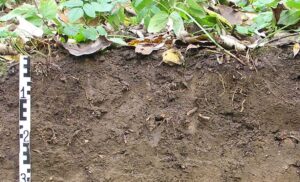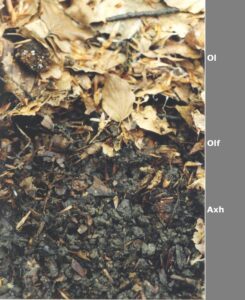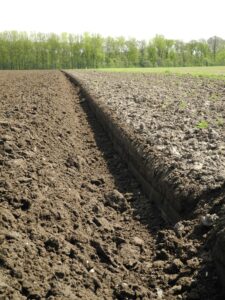Am
A modified A horizon, at the mineral soil surface in the current or former floodplain of a stream or in the marshland of the sea; with altered mineral contents due to sedimentation during flooding.
- The decomposition of organic matter predominates over the accumulation of new organic matter or
- Mixing (ploughing activity and peatland melioration) with mineral substrates decreases the organic matter content.
- A horizon with visible content of organic matter and
- organic carbon content < 15 mass % and
- with accumulation of in-situ organic matter, which may also originate from organic fertilization or fresh sedimentation.
- with admixture of organic soil matter and mineral soil material from periodic or episodic (from the Holocene) sedimentation during flooding by river or sea water; and
- higher base saturation or higher levels of nitrogen, phosphorus or heavy metals from the flood water and its sediment load or from the upward seepage water compared to the surrounding soils; and
- in case of ending of the fluvial flooding dynamics (diking), further accumulation of substances by upward seepage
Note: After the end of the flooding and the upward seepage dynamics, the Am horizon becomes relictic (rAm) and leads to the variety “relictic flooded” (ra) in the corresponding floodplain soil.
Ai
A modified A horizon, with initial soil formation and thus only low accumulation of organic matter [i from initial].
- The decomposition of organic matter predominates over the accumulation of new organic matter or
- Mixing (ploughing activity and peatland melioration) with mineral substrates decreases the organic matter content.
- A horizon with visible content of organic matter and
- organic carbon content < 15 mass % and
- with accumulation of in-situ organic matter, which may also originate from organic fertilization or fresh sedimentation.
- a) Organic carbon content ≥ 0.5 mass %, horizon patchily developed and < 2 cm thick or
b) Organic carbon content < 0.5 mass % and horizon ≥ 2 cm thick.
Ah
An A horizon with accumulated organic carbon, the content of which mostly decreases from top to bottom of the horizon [h from humic].
- The decomposition of organic matter predominates over the accumulation of new organic matter or
- Mixing (ploughing activity and peatland melioration) with mineral substrates decreases the organic matter content.
- A horizon with visible content of organic matter and
- organic carbon content < 15 mass % and
- Organic carbon content ≥ 0.5 mass % (h2) and
- the criteria for Ai-, Au-, Ab-, Ax- und Aa-Horizons are not fulfilled
Aih
Ah transition horizon (Ai-Ah), very thin, organic matter consists mostly of undecomposed plant remains/litter [i from initial].
- The decomposition of organic matter predominates over the accumulation of new organic matter or
- Mixing (ploughing activity and peatland melioration) with mineral substrates decreases the organic matter content.
- A horizon with visible content of organic matter and
- organic carbon content < 15 mass % and
- Organic carbon content ≥ 0.5 mass % and
- thickness < 2 cm and continuously developed
Au
A modified A horizon, with low base saturation. Dark-coloured because of humus, with well-developed and stable aggregate structure, not hardening when drying out, with pronounced bioturbation (earthworm activity, usually clearly visible deeper in the profile). Usually soil texture loamy sand (Sl3) or finer (more loamy). In forests usually humus form Mull [u from umbra].
- The decomposition of organic matter predominates over the accumulation of new organic matter or
- Mixing (ploughing activity and peatland melioration) with mineral substrates decreases the organic matter content.
- A horizon with visible content of organic matter and
- Organic carbon content≥ 1mass % and
- a) value ≤ 3 und chroma ≤ 4 or
- b) value ≤ 4 and chroma ≤ 3 and
- stable granular or stable fine subpolyhedral structure (aggregates< gro4) ≥ 50 % of the volume and
- earthworm burrows exist and
- base saturation (eff.) < 50 %
Ax
A modified A horizon, with higher base saturation, dark-coloured because of the humus, with well-development and stable aggregate structure, not hardening, when drying out, with pronounced bioturbation (earthworm activity). In Forests usually humus form L-Mull. Often affected because of ploughing [x from biological mixing] (Figure 6).
- The decomposition of organic matter predominates over the accumulation of new organic matter or
- Mixing (ploughing activity and peatland melioration) with mineral substrates decreases the organic matter content.
- A horizon with visible content of organic matter and
- Organic carbon content ≥ 0.5 mass % and
- a) value ≤ 3 und chroma ≤ 4 or
- b) value ≤ 4 and chroma ≤ 3 and
- stable granular or stable fine subpolyhedral structure (aggregates< gro4) ≥ 50 % of the volume and
- earthworm burrows exist and
- base saturation (eff.)< 50 %
Aa
A modified A horizon, developed under long standing groundwater or stagnic water conditions and inhibited mineralisation. Due to lack of oxygen, organic fine matter is extremely accumulated [a from anmoor].
- The decomposition of organic matter predominates over the accumulation of new organic matter or
- Mixing (ploughing activity and peatland melioration) with mineral substrates decreases the organic matter content.
- A horizon with visible content of organic matter and
- Organic carbon content of 8 to < 15 mass %, and
- developed under the influence of groundwater or stagnic water in the A horizon and
- under dry conditions fine subpolyhedral or granular structure and
- coherent and smeary when moist
Ab
A modified A horizon, developed after drainage from an H or U horizon, where decomposition of organic matter predominates compared to the accumulation of new organic matter, or where mixing (ploughing activity and peatland melioration) with mineral substrates decreases the organic matter content [b from Abbau (german for decomposition].
- The decomposition of organic matter predominates over the accumulation of new organic matter or
- Mixing (ploughing activity and peatland melioration) with mineral substrates decreases the organic matter content.
- A horizon with visible content of organic matter and
- Content of organic carbon from 8 to < 15 mass %; and
- developed after drainage from an H or U horizon and
- smeary when moist and
- single grain or subpolyhedral or fine polyhedral structure and
- black-coloured when moist, grey-or black-coloured when dry
Ap
A modified horizon, shaped by regular tillage and thus homogenised. Often contains mixed-in portions of the subsoil following below the A horizon. Horizon thickness corresponds to the depth of tillage [p from ploughed].
- The decomposition of organic matter predominates over the accumulation of new organic matter or
- Mixing (ploughing activity and peatland melioration) with mineral substrates decreases the organic matter content.
- A horizon with visible content of organic matter and
- homogenised by tillage and
- with clear or sharp and planar lower boundary (in relict and fossile horizons possibly without sharp edges).
Note: Ai, Ah, Au, Ax, Aa and Ab horizons witch fullfill the criteria of an Ap horizon are defined as modifierd horizons Aip, Ahp, Axp, Aup, Aap and Abp Horizons.
Hinweis: Ai-, Ah-, Ax-, Aa- und Ab-Horizonte, die die Kriterien des Ap-Horizonts erfüllen, bilden einen Abweichungshorizont mit dem Zusatzsymbol p. Bei diesen steht das Zusatzsymbol p hinten (z. B. Axp, Ahp).



